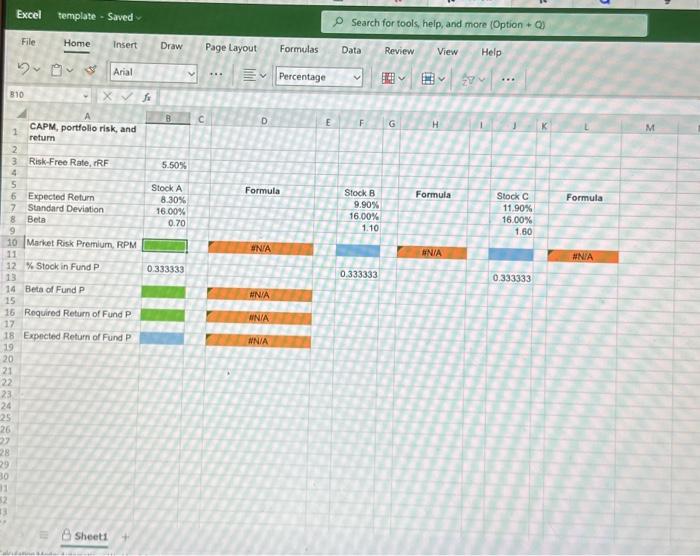help!!!!!!!!

Fund P has one-third of its funds invested in each of the three stocks. The risk-free rate is 5.5%, and the market is in equilibrium. (That is, required retur equal expected returns.) The data has been collected in the Microsoft Excel Online file below. Open the spreadsheet and perform the required analysis to answer the questions below. Open spreadsheet a. What is the market risk premium (rMrRF) ? Round your answer to two decimal places. % b. What is the beta of Fund P? Do not round intermediate calculations. Round your answer to two decimal places. c. What is the required return of Fund P? Do not round intermediate calculations, Round your answer to two decimal places. W d. Would you expect the standard deviation of Fund P to be less than 16%, equal to 16%, or greater than 16% ? I. less than 16% II. greater than 16% III. equal to 16% Sheet1 Excel Online Structured Activity: CAPM, portfolio risk, and return Consider the following information for three stocks, Stocks A, B, and C. The returns on the three stocks are positively correlated, but they are not perfectly correlated. (That is, each of the correlation coefficients is between 0 and 1.) Fund P has one-third of its funds invested in each of the three stocks. The risk-free rate is 5.5%, and the market is in equilibrium. (That is, required returns equal expected returns.) The data has been collected in the Microsoft Excel Online file below. Open the spreadsheet and perform the required analysis to answer the questions below. Open spreadsheet d. What is the market risk premium (rM=rRF) ? Round your answer to two decimal places. % b. What is the beta of Fund P? Do not round intermediate calculations. Round your answer to two decimal places. c. What is the required return of Fund P? Do not round intermediate calculations, Round your answer to two decimal places. % d. Would you expect the standard deviation of Fund P to be less than 16%, equal to 16%, or greater than 16% ? 1. Jess than 16% Fund P has one-third of its funds invested in each of the three stocks. The risk-free rate is 5.5%, and the market is in equilibrium. (That is, required retur equal expected returns.) The data has been collected in the Microsoft Excel Online file below. Open the spreadsheet and perform the required analysis to answer the questions below. Open spreadsheet a. What is the market risk premium (rMrRF) ? Round your answer to two decimal places. % b. What is the beta of Fund P? Do not round intermediate calculations. Round your answer to two decimal places. c. What is the required return of Fund P? Do not round intermediate calculations, Round your answer to two decimal places. W d. Would you expect the standard deviation of Fund P to be less than 16%, equal to 16%, or greater than 16% ? I. less than 16% II. greater than 16% III. equal to 16% Sheet1 Excel Online Structured Activity: CAPM, portfolio risk, and return Consider the following information for three stocks, Stocks A, B, and C. The returns on the three stocks are positively correlated, but they are not perfectly correlated. (That is, each of the correlation coefficients is between 0 and 1.) Fund P has one-third of its funds invested in each of the three stocks. The risk-free rate is 5.5%, and the market is in equilibrium. (That is, required returns equal expected returns.) The data has been collected in the Microsoft Excel Online file below. Open the spreadsheet and perform the required analysis to answer the questions below. Open spreadsheet d. What is the market risk premium (rM=rRF) ? Round your answer to two decimal places. % b. What is the beta of Fund P? Do not round intermediate calculations. Round your answer to two decimal places. c. What is the required return of Fund P? Do not round intermediate calculations, Round your answer to two decimal places. % d. Would you expect the standard deviation of Fund P to be less than 16%, equal to 16%, or greater than 16% ? 1. Jess than 16%










